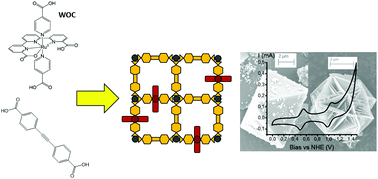Synthetic strategies to incorporate Ru-terpyridyl water oxidation catalysts into MOFs: direct synthesis vs. post-synthetic approach†
Abstract
Incorporating molecular catalysts into metal–organic frameworks (MOFs) is a promising strategy for improving their catalytic longevity and recyclability. In this article, we investigate and compare synthetic routes for the incorporation of the potent water oxidation catalyst Ru(tda)(pyCO2H)2 (tda = 2,2′:6′,2′′-terpyridine-6,6′′-dicarboxylic acid, pyCO2H = iso-nicotinic acid) as a structural linker into a Zr-based UiO-type MOF. The task is challenging with this particular metallo-linker because of the equatorial dangling carboxylates that can potentially compete for Zr-coordination, as well as free rotation of the pyCO2H groups around the HO2Cpy⋯Ru⋯pyCO2H axis. As a consequence, all attempts to synthesize a MOF with the metallo-linker directly under solvothermal conditions led to amorphous materials with the Ru(tda)(pyCO2H)2 linker coordinating to the Zr nodes in ill-defined ways, resulting in multiple waves in the cyclic voltammograms of the solvothermally obtained materials. On the other hand, an indirect post-synthetic approach in which the Ru(tda)(pyCO2H)2 linker is introduced into a preformed edba-MOF (edba = ethyne dibenzoic acid) of UiO topology results in the formation of the desired material. Interestingly, two distinctly different morphologies of the parent edba-MOF have been discovered, and the impact that the morphological difference has on linker incorporation is investigated.



 Please wait while we load your content...
Please wait while we load your content...